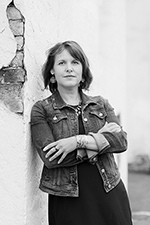 Volunteer Kathy Mak talks with the spring issue #222 contributor about metabolizing complex feelings, her interest in the myth of Inanna, and writing as a way to process memories and grief in her essay, "Preparing the Eulogy."
Volunteer Kathy Mak talks with the spring issue #222 contributor about metabolizing complex feelings, her interest in the myth of Inanna, and writing as a way to process memories and grief in her essay, "Preparing the Eulogy."
KM: “Preparing the Eulogy” is written in fragments, but these fragments mirror the way memory works—how certain moments are retained clearer than others and not necessarily in chronology. Layered like an onion, each fragment reveals the fluctuating nature and complexity of a father-daughter relationship that can feel exposing and vulnerable. What was the process like for writing this piece? Were there moments that you found easier or harder to write than you initially thought?
SIH:
Right after my father died, a whack of memories surfaced and writing this piece was part of my grief process. It may have been an attempt to hold on to him a little longer, and a way to free myself to tell the stories about some behavior I’d covered up my whole life. In my first draft, I had titled each vignette with the kind of memory I had: sad, funny, confused, etc. When I went into revision, I wanted the memories to stand on their own without my interpretation: simple snapshots of time and place. Writing about his violence was obviously tough but it was equally challenging to write about his kindness and feel my tenderness for him. I didn’t just lose my father, who loved me deeply and imperfectly, I also lost my living link to Egypt and my visible identity as an immigrant. This is one of several pieces I wrote about him in the year following his death.
Read the rest of S. I. Hassan's interview.
Sue Goyette, issue #222 poetry contributor
 Volunteer Elizabeth Adilman talks with the spring issue #222 contributor about repetition as a tuning fork, needing time to recharge, and the hybrid form of her essay/poem, "In which Haraway’s ‘multispecies flourishing’ radiates over the threshold of death to mothers and sisters by way of two endangered wolves on a live cam at this late stage of, well, everything."
Volunteer Elizabeth Adilman talks with the spring issue #222 contributor about repetition as a tuning fork, needing time to recharge, and the hybrid form of her essay/poem, "In which Haraway’s ‘multispecies flourishing’ radiates over the threshold of death to mothers and sisters by way of two endangered wolves on a live cam at this late stage of, well, everything."
EA: The late Steven Heighton in his workbook, Memos and Dispatches on Writing defines poetry as: “The art of calling things by their true and secret name.” And, you have said: “I speak in poetry” in a conversation with translator Georgette Le Blanc about your book, Ocean. What was your hope in writing, “In Which Haraway’s…”? What are you naming?
SG:
I’m grateful for Steve’s company in this question. Thank you for bringing his good words to our conversation. I consider this “poetry” I claimed in that quote and your “naming” as verbs, or as ways of being. I wrote “In which Haraway’s…” as a way of recording the cresting and active experience of the days leading up to and following my mother’s dying and the revelation of finding out that she had birthed a daughter before our family who she’d given up for adoption. That was a total shock and, adding to the surprise, was that she’d come to Halifax to give birth all those years ago, a city she had no ties to but chose randomly, and stayed at a nunnery that was literally two blocks from my house and on a street I walk most days. This collision of her earlier self with this specific place and time in such close proximity to me now still astounds me. The work is addressing this half-sister and the more general idea of the complexity of connections and synergy and temporal fluidity.
Read the rest of Sue Goyette's interview.